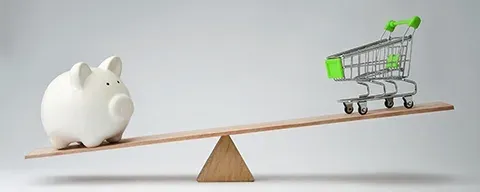Spend or save? How to use your tax refund.
November 30, 2016|Updated: April 8, 2025

Canadians have lots of options when it comes to their refund, let us explore some ideas to make your refund work best for you.
Hoping for a refund or government benefits is one thing many Canadians look forward to when doing their taxes. Knowing a cheque is in the mail is always appealing, and some taxpayers already have their money spent well before the actual cheque arrives. Now that Canadians are receiving their refund and benefit amounts, what’s the best way to allocate these funds?
Many taxpayers will put their money towards repaying debts or increasing savings, while others might spend it on a vacation or other fun-filled activities. While a shopping spree offers some short-term satisfaction, your financial situation could easily improve by giving your funds some more thought.
Planning for your tax refund: Where to start.
Understanding the difference between your needs and your wants will help your refund go further. We need food, shelter and clothing, but of course we want new computers and fancier cars. If replacing some wardrobe items is a must, considering the cost of designer brands versus generic brands can help you get the most out of your spend. For example, a pair of running shoes can cost anywhere from $25 to $300, so try to avoid overspending where possible.
Another way to get the most out of spending your refund? Avoid high-interest credit card purchases. Remember, when making a purchase using credit, the price you pay does not reflect the final cost. A great “Back To School” jacket that seemed like a deal at $75 can really cost upwards of $250, if purchased with a credit card by the time the bill is paid.
Here are some other ideas to consider when deciding if you should spend or save your tax refund:
Cover your needs:
If you are having a hard time making ends meet for necessities, such as food and shelter, then your refund should be allocated here.
Build up your emergency fund:
If your needs are covered, consider putting the money in an emergency fund. You never know when an unanticipated cost might come up, and putting money aside now means not having to scramble later.
Tackle high-interest debt:
Pay off any debt with a high interest rate, such as a credit card bill. Though it may not feel like it, you will be saving money over the long term by not paying sky-high interest.
Split it up:
Consider using a portion of the refund to pay off credit card debt and directing the rest to your emergency fund. This will enable you to reduce your interest payments, and also put aside money to cover unexpected expenses in the future.
Invest in your TFSA:
Tax-free Savings Accounts (TFSAs) are a fantastic way to save money now and in the future. As your money grows, any interest earned is tax free. By placing funds in your TFSA every year, you are saving on your taxes, when compared to an investment that is not in your TFSA.
More on TFSA’s.
Anyone 18 or over can contribute to a TFSA. In 2017, the yearly maximum is $5,500 (plus any unused contribution room from previous years, which is indicated on your Notice of Assessment). You may withdraw money at any time from your TFSA and it does not affect your tax situation. However, be careful not to over contribute. If you are at your maximum and you take money out, you must wait until the following year to regain the contribution room otherwise you will be subject to a penalty.
Save for retirement:
If you contribute to your RRSP, not only are you saving for the future, you are also saving on your taxes. The benefit of an RRSP deduction is that it reduces your taxable income. Generally when you withdraw your RRSP for your retirement, you are in a lower tax bracket and this means you are paying less tax on that initial money. If you borrowed money to make an RRSP contribution, use your tax refund to help pay off the loan.
More money on hand is always nice, but remember, tax refunds are in fact money you overpaid the government last year. You are simply getting your own money back, based on your personal situation. Ideally, you want to owe the government nothing when you file your return, and vice versa. If your situation has changed over the year, you can ask your payroll department to update your TD1 Form to reflect the changes. It may mean you don’t get a refund next year, but you can appreciate a few extra dollars on every paycheque.
H&R Block offers a variety of tax preparation services, covering all your needs. Our tax advisors are here to offer convenient, accurate, and affordable help for any tax situation you might have.